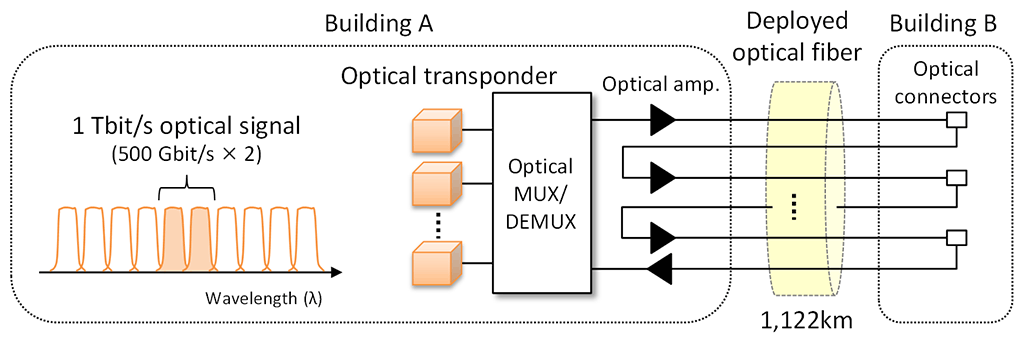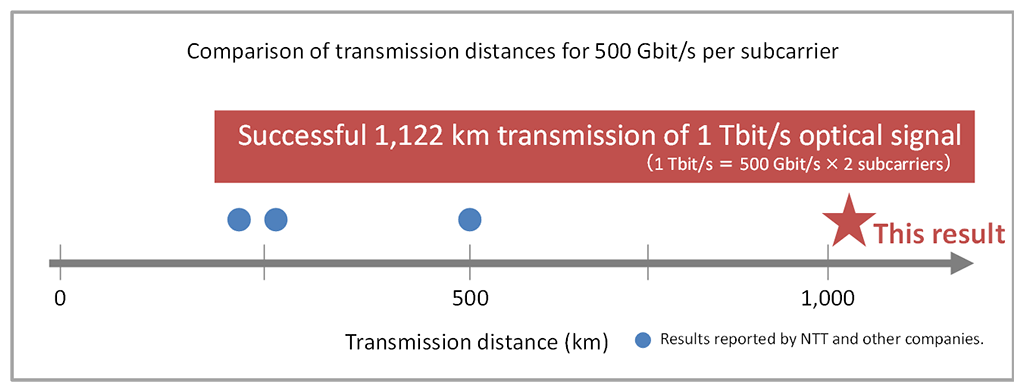Microsoft ends support for Internet Explorer on June 16, 2022.
We recommend using one of the browsers listed below.
- Microsoft Edge(Latest version)
- Mozilla Firefox(Latest version)
- Google Chrome(Latest version)
- Apple Safari(Latest version)
Please contact your browser provider for download and installation instructions.
June 19, 2019
NTT
Long-Distance Transmission of 1 Tbit/s Ultra-High-Capacity Optical Signal
-World record 1,122 km transmission in a commercial environment-
Nippon Telegraph and Telephone Corporation (NTT) and NTT Communications Corporation (NTT Com) have successfully demonstrated long-distance transmission of a 1 Tbit/s optical signal in a commercial environment.
A 1 Tbit/s optical signal using wavelength division multiplexed technique was successfully transmitted over a world-record breaking distance*3 of 1,122 km. This was achieved using a new large-core low-loss optical fiber cable*1 deployed in NTT Com's commercial environment, which reduces optical losses and non-linearity, and original NTT technologies including: (1) a precise calibration technology that compensates for imperfections in the optical transponder and enables high-quality multi-order modulation optical signals to be transmitted and received, (2) an optical transponder integrating a digital signal processor that implements the latest digital coherent technology*2, and high-bandwidth optical front-end circuits, and (3) transmission line design technology.
This result should lead to transmission speeds ten-times that of systems currently in use (100 Gbit/s per channel) and an 80% or greater reduction of power consumption per bit. As such, it is anticipated as a high-capacity communications network technology for expansion of 5G services and realizing the IOWN*4 concept in the future.
1.Background
With recent expansion of video data distribution, development of cloud technologies, and the spread of new information and communication services such as 5G, network traffic is expected to continue increasing. To meet these demands, the capacity of backbone optical networks must be expanded economically. To do so, NTT and NTT Com are developing technologies of the highest global standard for economical expansion of the capacity of deployed optical transmission systems.
2.Overview of experiment
For this experiment, an environment was built to transmit 1 Tbit/s optical signals in wavelength division multiplexing condition over a world-record distance*3 of 1,122 km, using a new large-core low-loss optical fiber cable*1 that reduces optical losses and non-linearity, deployed in NTT Com's commercial environment, and new optical transponders developed by NTT (Figure 1).
 Figure 1 Schematic of transmission experiment
Figure 1 Schematic of transmission experiment
A 1 Tbit/s optical signal was generated using digital coherent technology with an optical transponder integrating an advanced digital signal processor and high-bandwidth optical front-end circuits, and two-subcarrier multiplexing*6 of polarization-division multiplexed 32QAM*5 signals (500 Gbit/s per wavelength), which increases information capacity by encoding information in the polarization, phase and amplitude of the optical signals. This made it possible to achieve transmission speeds of 1 Tbit/s, which is ten times that of current systems that achieve 100 Gbit/s per channel. By increasing the per-wavelength transmission capacity, we can expect to reduce per-bit power consumption by more than 80% relative to existing equipment. Original NTT technology has also enabled precise calibration, compensating for imperfections in the transponder (signal path length, variation in signal path losses, etc.) and making received signals closer to the ideal signal, so that high-quality signals can be transmitted and received (Figure 2). This has enabled the successful transmission of a high-order 32QAM optical signal over the world-record distance of 1,122 km, which requires high signal quality and is technically extremely difficult (Figure 3).
Note that this work was partly supported by "The research and development project for the Tera-bit optical network technologies towards big data era" and "The research and development of innovative optical network technology as a new social infrastructure" of the Ministry of Internal Affairs and Communications, Japan.
 Figure 2 Precise calibration technology
Figure 2 Precise calibration technology
 Figure 3 This result and other reported test results
Figure 3 This result and other reported test results
3.Future prospects
To realize IOWN, we will work to further extend and develop state-of-the art 1 Tbit/s-class optical transmission technology, with the objective of innovative networks based on end-to-end photonics technology and yielding high-capacity, low-latency, and excellent flexibility and power consumption. We will promote implementation of high capacity, economical networks including high-capacity optical transmission systems using these results and high-performance optical fiber transmission links. We will also work for global deployment of these results in collaboration with facilities in Japan and internationally.
Glossary
- *1Large-core low-loss optical fiber cable is a new type of optical fiber that reduces the amount of attenuation of optical signal passing through it compared to earlier fiber, and suppresses degradation of optical signal quality by expanding the diameter of the optical fiber core (compliant with ITU-T G.654.E).
- *2Digital coherent technology is a method combining digital signal processing and coherent detection. Coherent detection is a technology that enables detection of the amplitude and phase of an optical signal by having a local oscillator at the receiver interfere with the received optical signal. Spectral efficiency can be improved using modulation schemes such as polarization multiplexing and phase modulation, and reception sensitivity can be greatly improved using digital signal processing for precision optical signal equalization and coherent reception.
- *3As of May 2019, reviewed by NTT Com and NTT.
- *4IOWN: "Innovative Optical & Wireless Network" See the "NTT Technology Report for Smart World: What's IOWN?" publication at
http://www.ntt.co.jp/news2019/1905/190509b.html - *5QAM (Quadrature Amplitude Modulation) is a modulation scheme that encodes information on both the amplitude and the phase of an optical signal. 32QAM is able to transmit 5 bits of information at a symbol. Applying this modulation scheme to each of the two independent polarizations of an optical signal results in a polarization-division multiplexed signal with double the transmission capacity.
- *6Subcarrier multiplexing is a type of multiplexed transmission that forms an ultra-high-speed channel by partitioning it into optical signals (subcarriers) of multiple wavelengths. Multiplexing two subcarriers with 500 Gbit/s polarization-division multiplexed 32QAM optical signals generates a 1 Tbit/s per channel optical signal.
Inquiries
Nippon Telegraph and Telephone Corporation
Science and Core Technology Laboratory Group, Public Relations Office
Tel. +81-46-240-5157
NTT Communications Corporation
Public Relations
Tel. +81-3-6700-4010
Information is current as of the date of issue of the individual press release.
Please be advised that information may be outdated after that point.
NTT STORY
WEB media that thinks about the future with NTT









